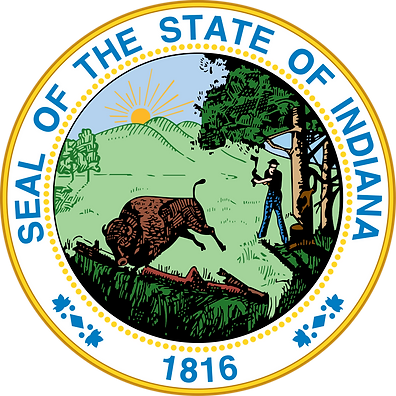History of the Noble County Courthouse
Noble County was organized in 1836 by an act of the Legislature and the appointed Commissioners originally chose Sparta as the county seat, though no county buildings were ever erected there. Residents objected to the erection of buildings so far from the center of the county and the Commissioners then agreed on a new location, Augusta, a point two miles west of Albion. A Courthouse and jail were built at that location in 1837 and in 1843 the courthouse was accidentally destroyed by fire.
See the timeline of events below photos.
-
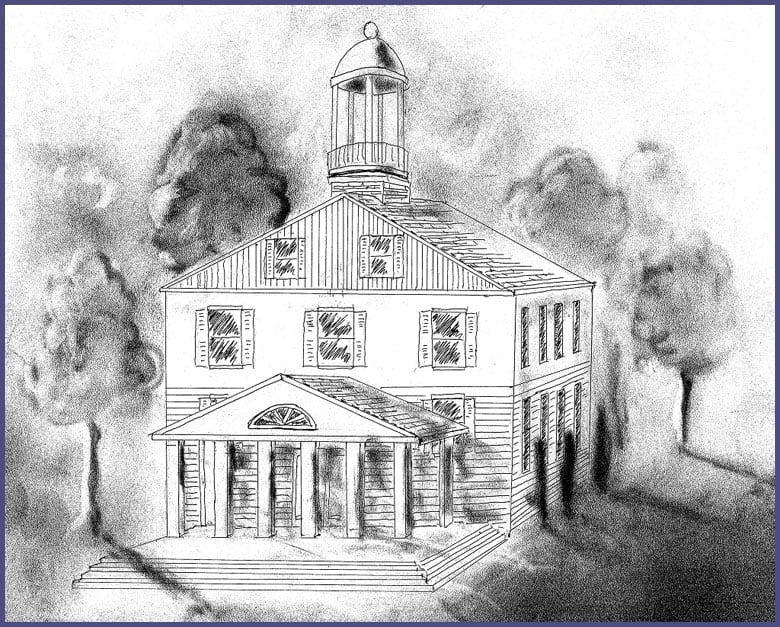
Artist Bill Burtnett’s sketch of the first Courthouse in Albion, based upon a sketch of the Northumberland County, PA Courthouse and a description of our Courthouse found in local newspapers. This courthouse burned in 1859. -
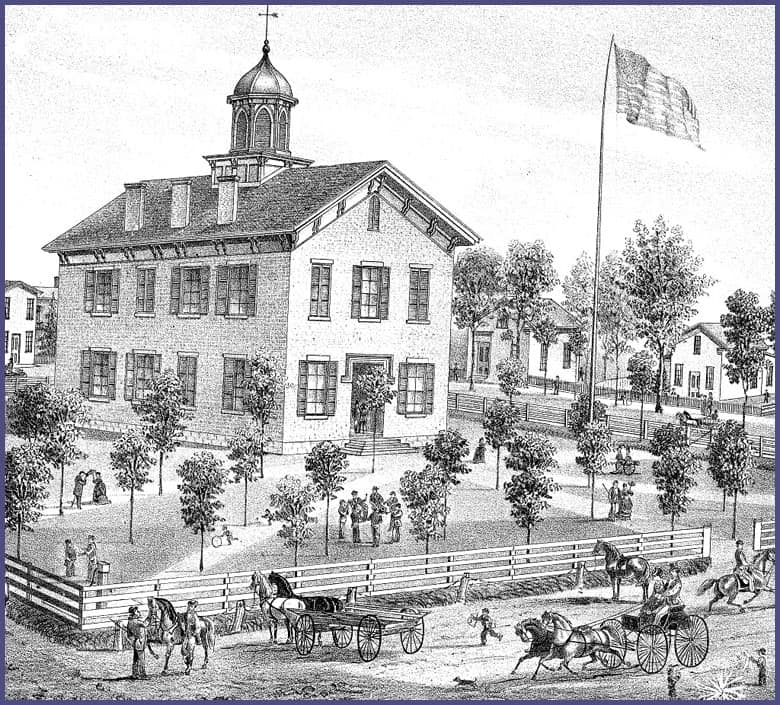
Unknown artist sketch of the second Courthouse in Albion, probably sketched in the early 1860’s. -
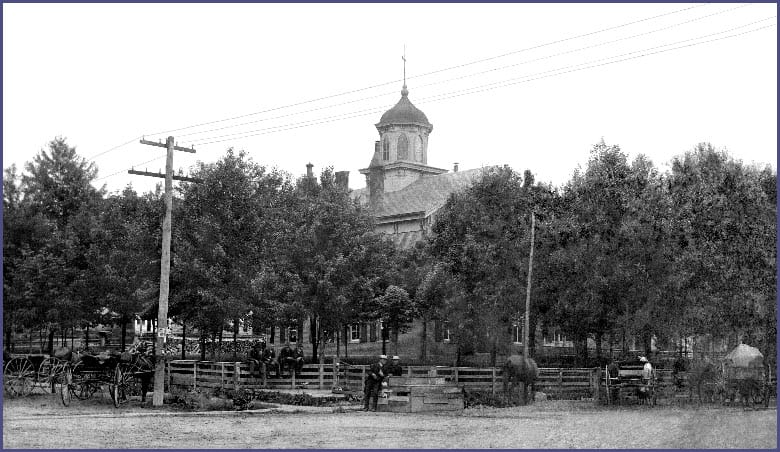
Photo of second Courthouse in Albion, taken in the 1880’s. Note the old pump and firewood stack. This building was about the size of the space occupied today by the Circuit and Superior I courtroom. -
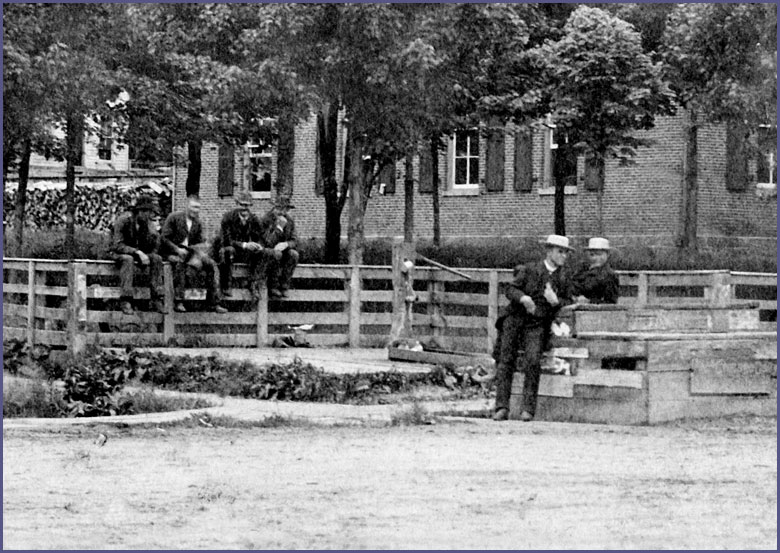
A “hard day” in front of the second Courthouse. -
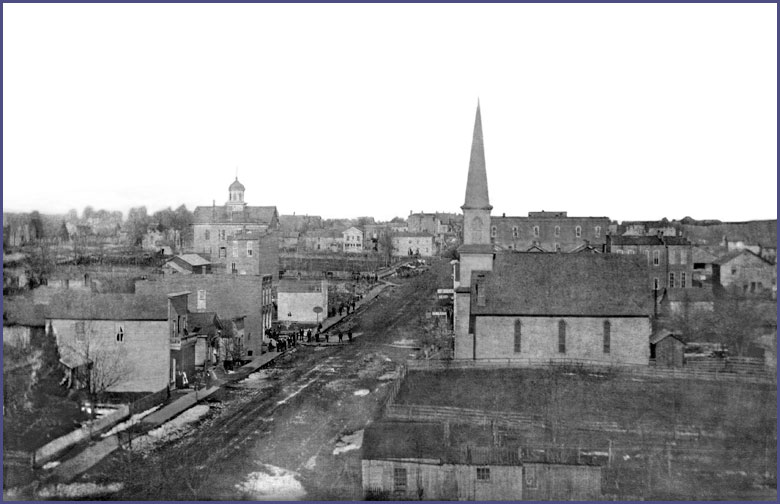
Photo from 1878 of second Courthouse and Methodist Church as seen looking from the south. -
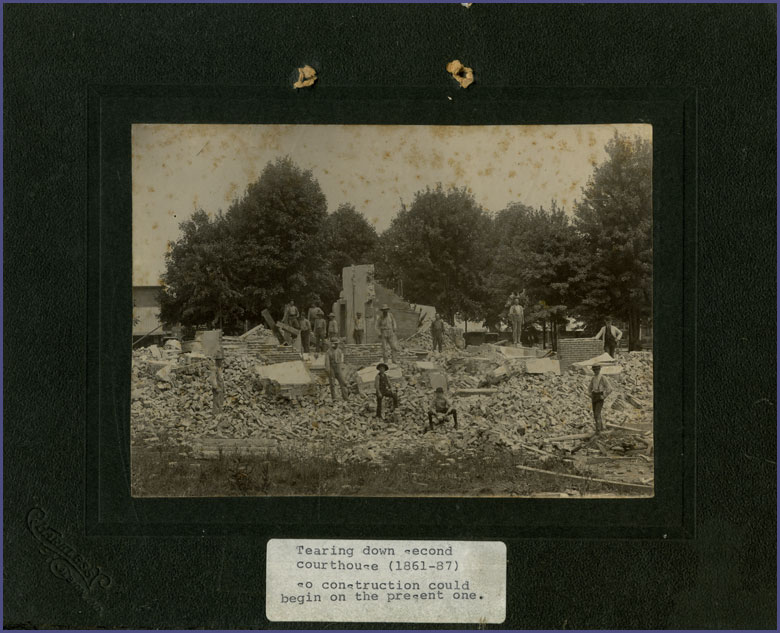
Having outgrown its space, the demolition of the second Courthouse began in August 1887. -
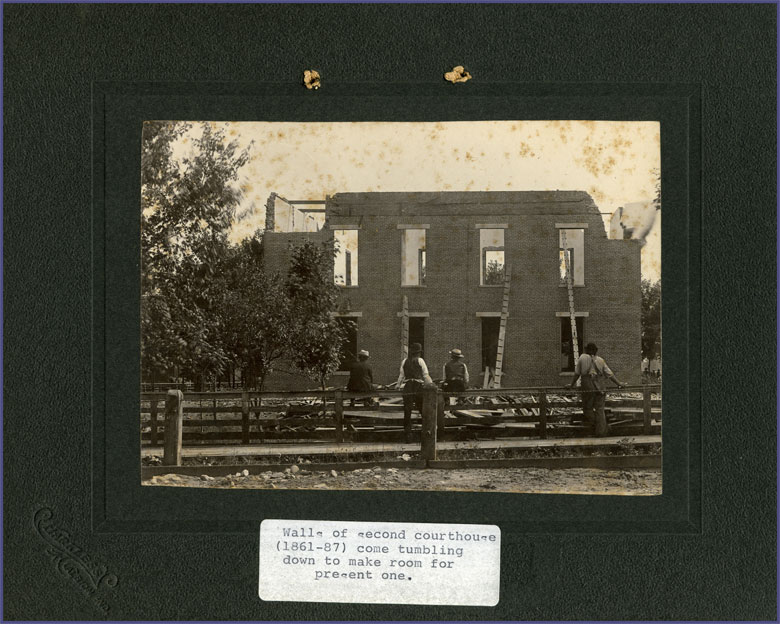
During the demolition of the second Courthouse and until the present Courthouse was completed in 1889, the county operated from the old Opera House. -

-
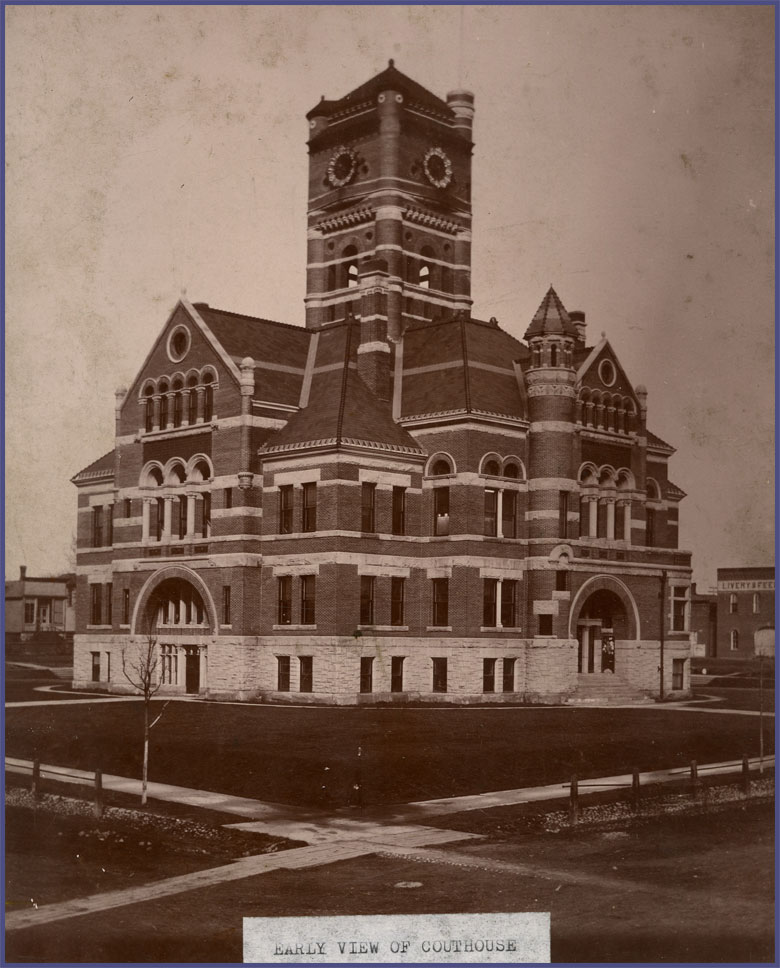
-
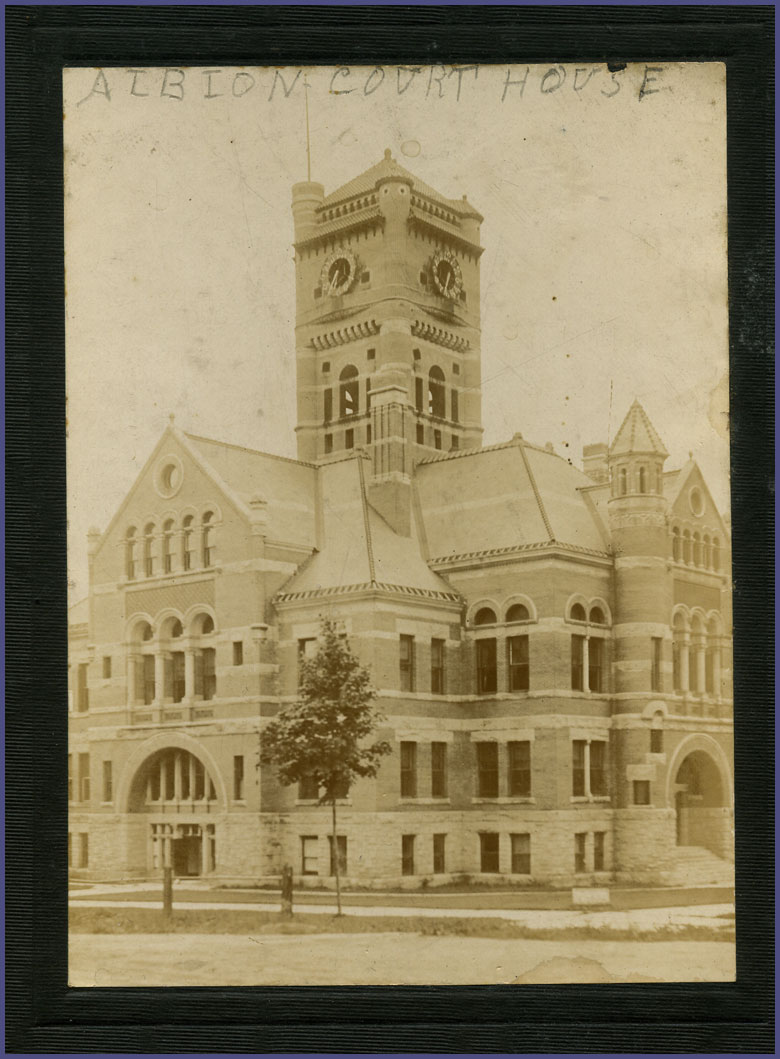
-

-
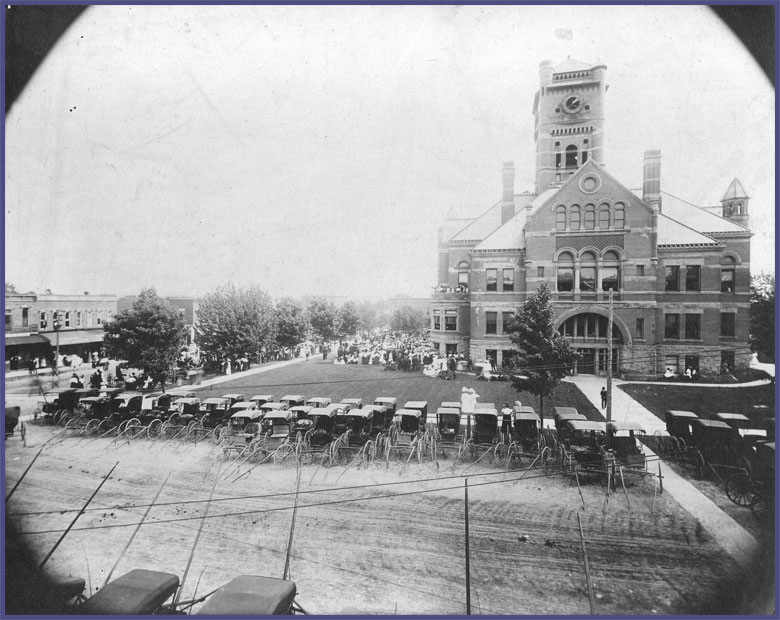
On Commencement Day, May 27, 1900, eighth graders from all Township schools in the county received their diplomas. A 75% average was required. -
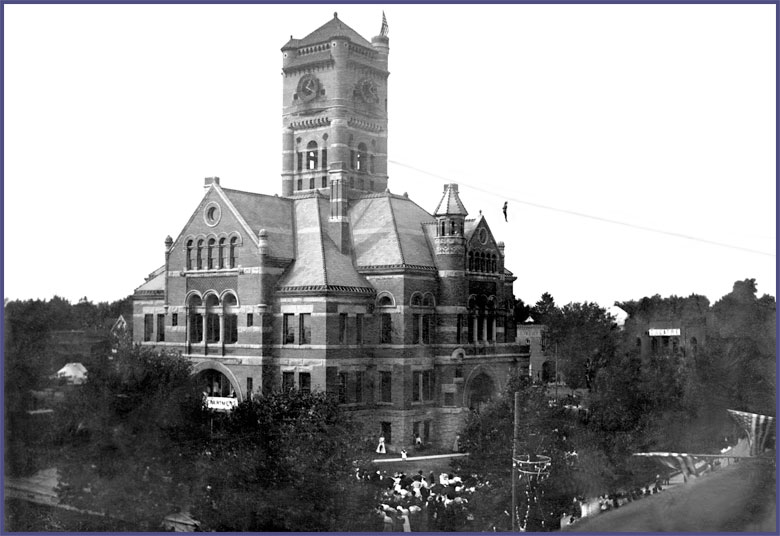
Ethel Scarver, performing under the name “Madame La Fere”, is shown on September 24, 1908, sliding on an 800 foot wire attached from the top of the Courthouse and anchored in the alley due east on North Orange Street during the Albion Street Fair. She fell to her death the following day when the wire snapped as she was sliding down. -
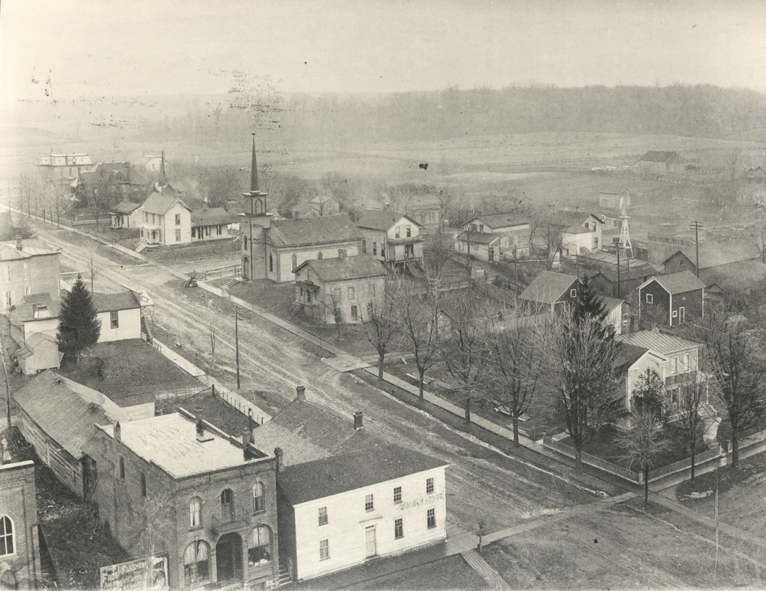
North Orange Street hill seen from the Courthouse tower, circa 1900. Note the white framed Worden House, early hotel moved to Albion from Port Mitchell in 1846 or 1847. Note across Orange Street the 1855 Greek Revival home of prominent banker and Common Pleas Judge William Clapp. The original St. Mark’s Lutheran Church is shown to the north. This church housed county offices after the original Courthouse was burned in 1859. The church was torn down in 1906 when the current church was built.
First Courthouse Built
In 1844, Commissioners relocated the seat of justice to Port Mitchell and a temporary building was erected for a courthouse. Soon after, however, the Legislature passed an act that provided for an election in 1846 to choose a county seat. In June 1846, Albion (then known as the "Center") was chosen and a frame courthouse was built on this site in 1847 by Samuel T. Clyner for the sum of $4,045.00. It resembled a courthouse in Sunbury, PA.
First Courthouse Burns
The courthouse was again destroyed by fire on January 25, 1859, and arson was suspected.
Second Courthouse Built
The second courthouse on this site was built by George Harvey in 1861 at a cost of $11,000.00. The building soon became too small and it was decided to build a larger building on this site.
Larger Building Started
In the fall of 1887, the second courthouse was demolished and construction soon began on the current courthouse.
Cornerstone Laid
Architect Edward O. Fallis designed the Romanesque structure for the cost of $114,062.41. The cornerstone was laid on May 29, 1888, and it was dedicated on October 15, 1889, a remarkable construction achievement.
Life Size Portraits Added
In 1904 an Italian artist, Giovenni Gioscio painted life-size portraits in the courthouse rotunda of George Washington, Abraham Lincoln, Andrew Jackson, and recently assassinated William McKinley.
Superior Courts Added
Two Superior Courts were added to the original Circuit Court due to increased population and case filings and courtrooms were created.
Placed on the National Registry
In 1981 the Noble County Courthouse was placed on the National Register of Historic Places.
Circuit Courtroom Renovated
In 2002 the original Circuit Courtroom was renovated and restored. Modern video and wireless internet technology were added as well. Rededication was held on November 30, 2003.
-
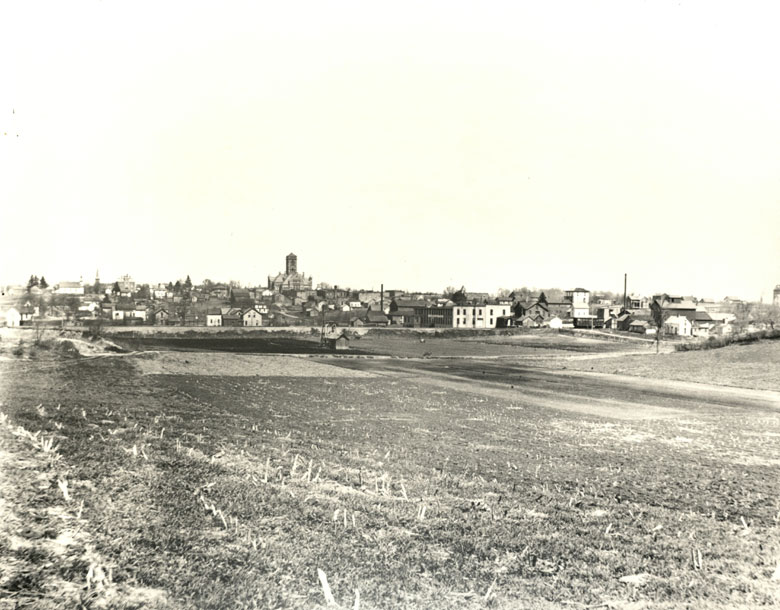
Albion Skyline, viewed north from River Road, circa 1900. Visible are Atwood Buggy Factory near railroad tracks, United Brethren Church, Presbyterian Church steeple, Old Jail, Courthouse, Methodist Episcopalian Church and Albion School. -
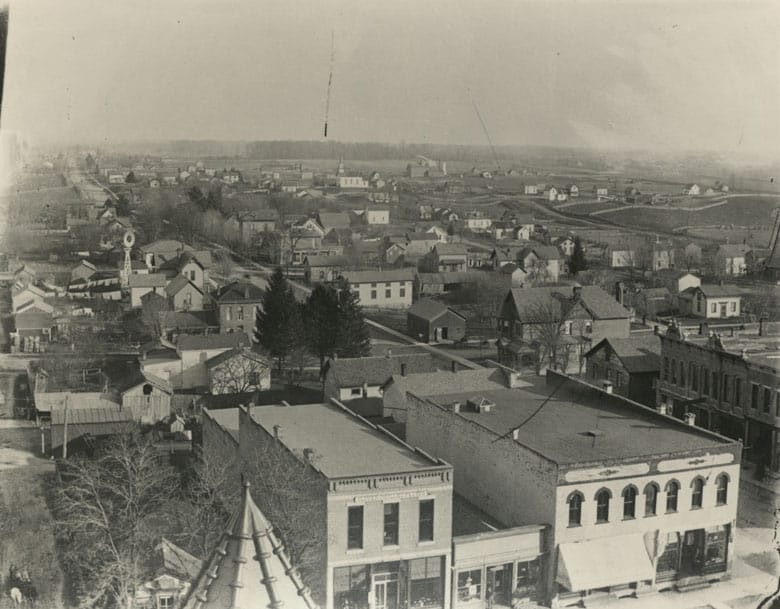
East Main Street view from Courthouse tower. Visible in distance is white frame building housing first Catholic Church. Circa 1900. -
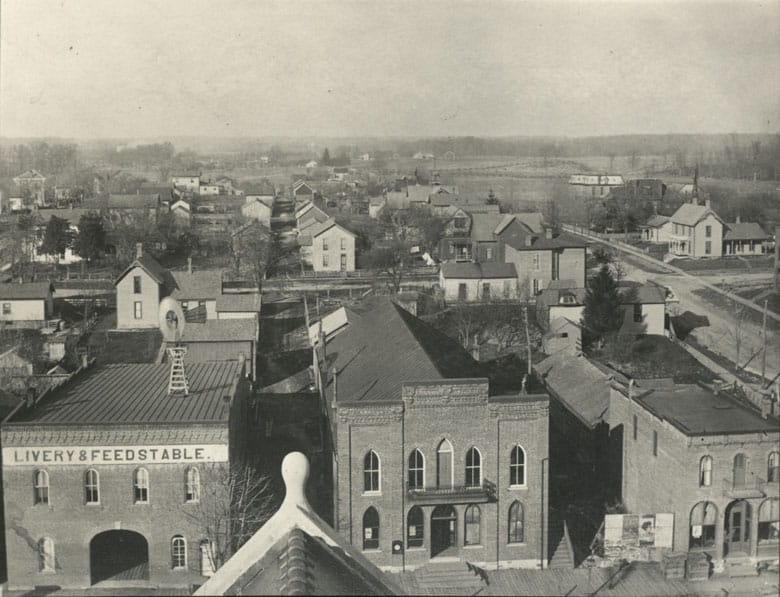
Jefferson Street north view from Courthouse tower, circa 1900. Visible is the former Opera House, where plays were performed and Albion High School basketball games were played on the second floor. See the billboard near the Opera House steps advertising the next play. Lutheran Church steeple is visible on the right. Note the windmill on the roof of the Livery and Feed Stable which provided water for the horses and the wooden sidewalk in front. -
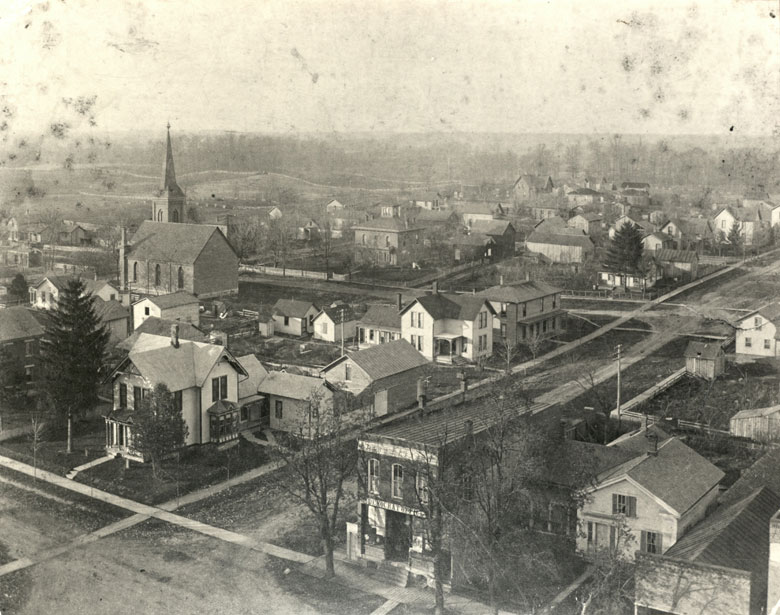
Northwest view from Courthouse tower, circa 1900. Visible are homes of early, the Presbyterian Church and the corner office of the Democrat newspaper. -

Photo of Courthouse with Flags and Photo of Ferris Wheel -
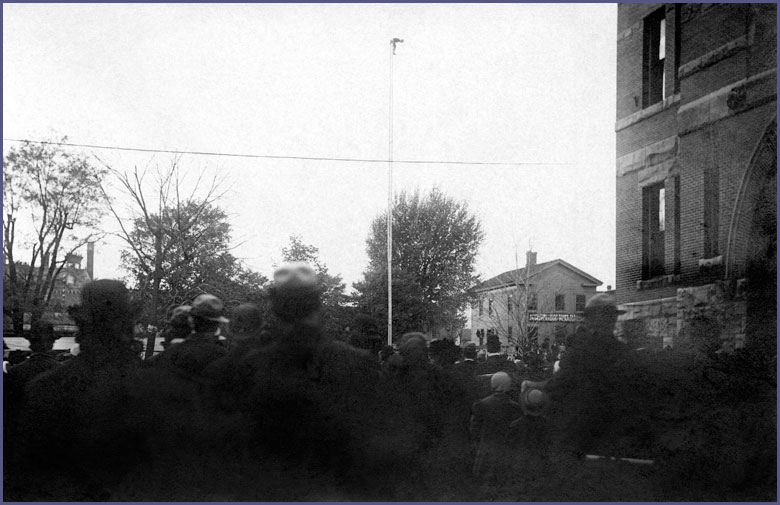
Unknown performer prepares to dive from a 90 foot ladder into a large barrel of water at the 1909 Albion Street Fair. -
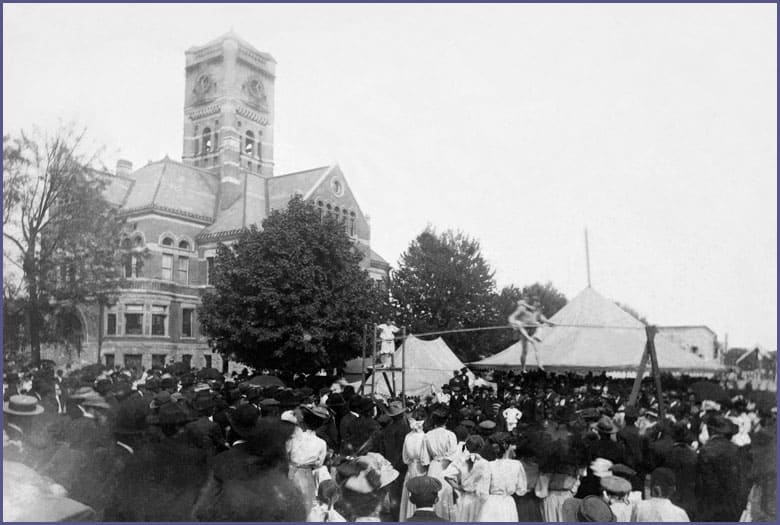
Unknown circus stars perform at the 1907 Albion Street Fair. -
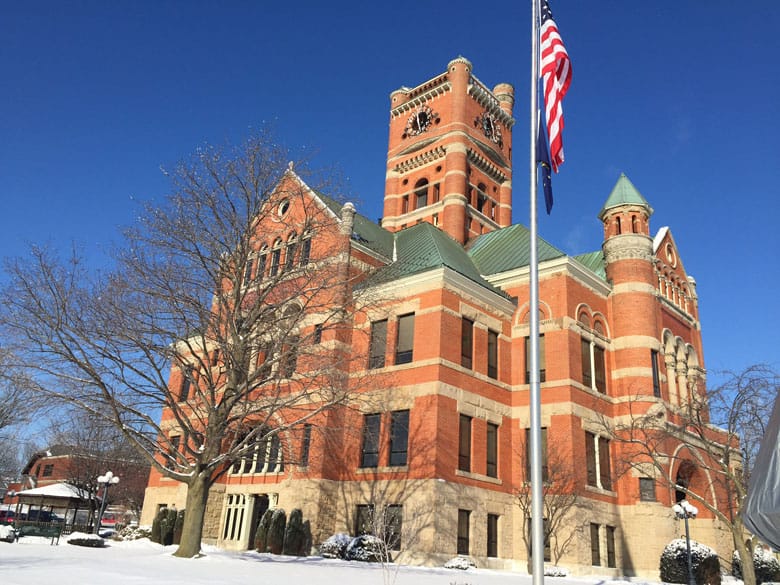
-
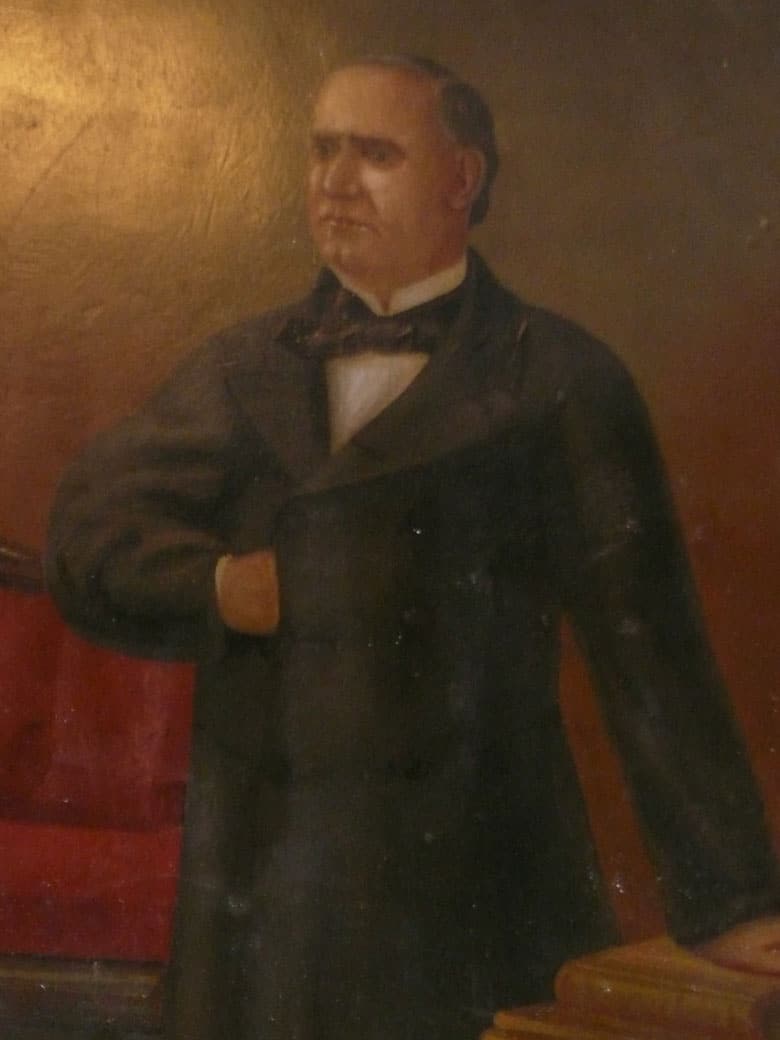
-
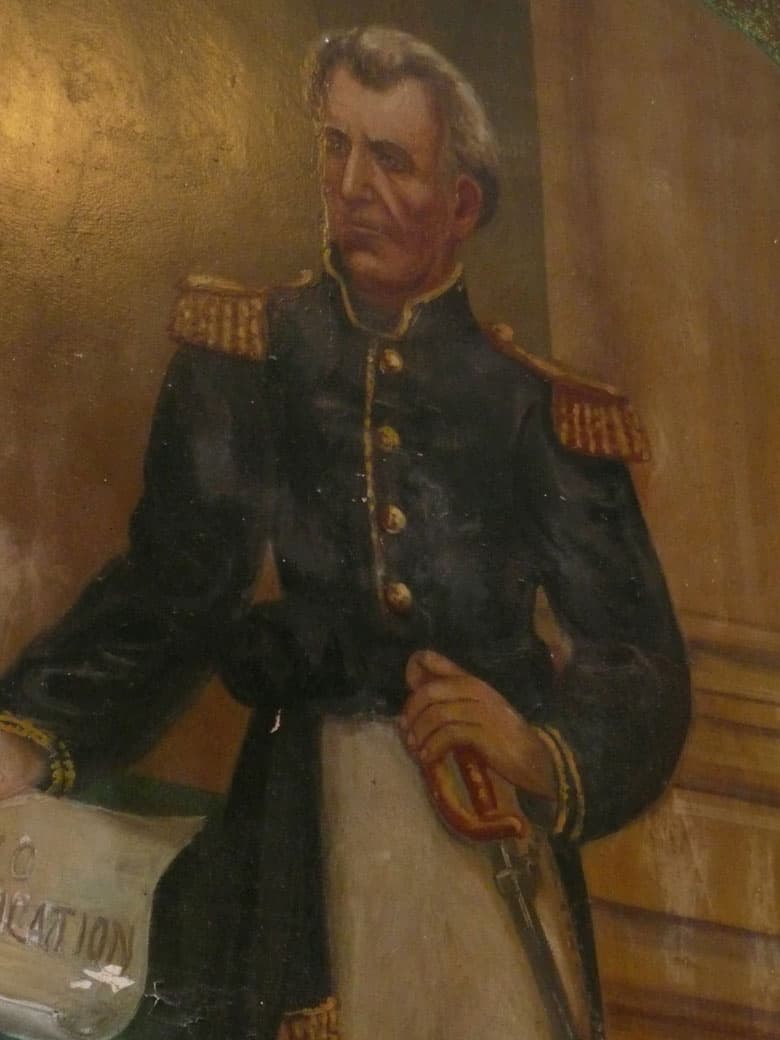
-
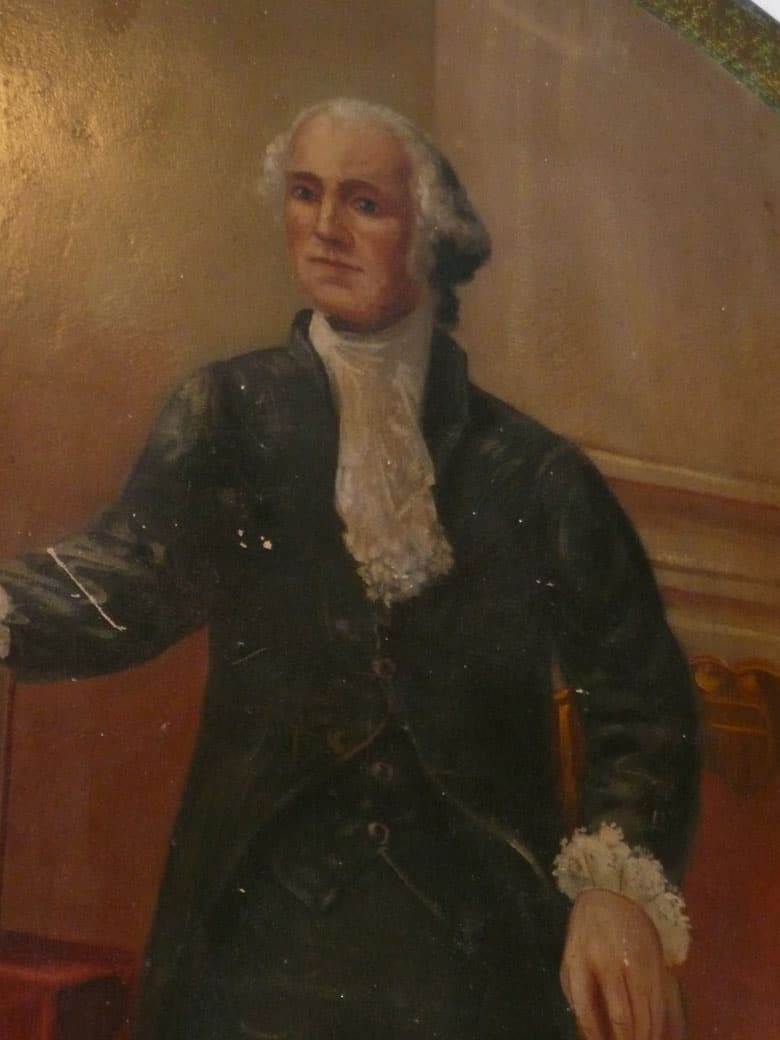
-
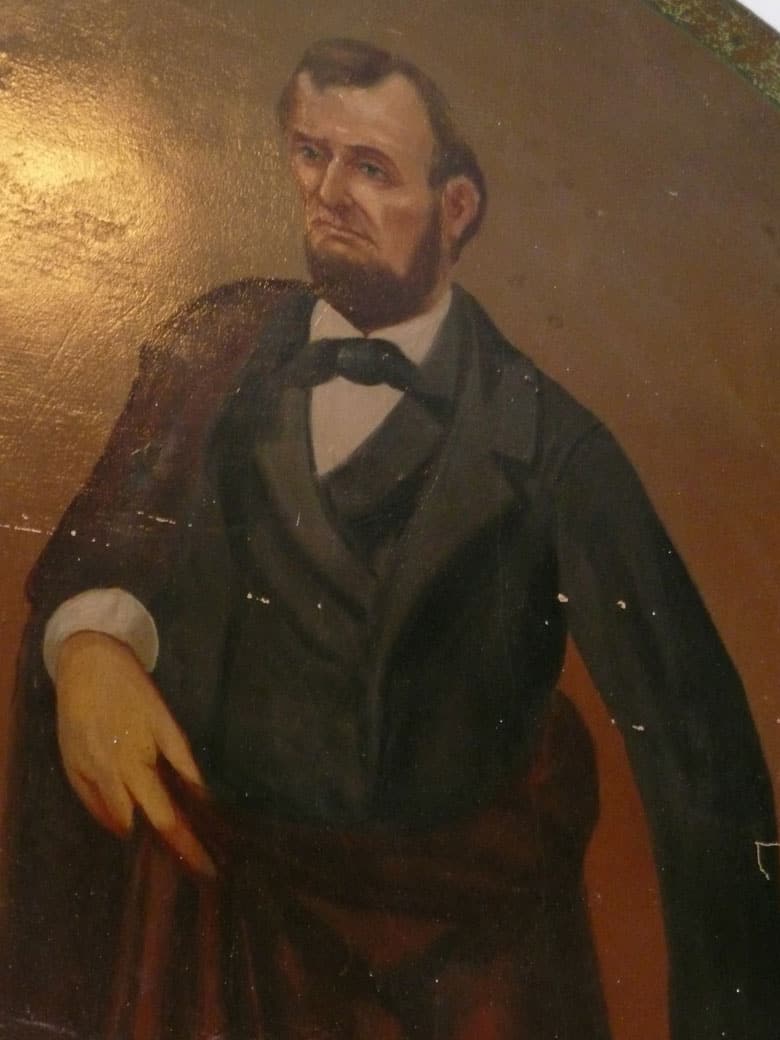
-

NICHOLS RELIEF MAP This one of a kind 1876 relief cast iron map was placed on display by Bob Wilson. The map pieces were brought to Albion by Captain Albert Black. The pieces were assembled by then Postmaster Carey Davis. The map reflects the states and territories as they existed at that time. Mountain ranges are raised. Large bodies of water are shown in blue. The Dakotas were one territory at that time and Oklahoma is labeled “Indian Territory”. The map was manufactured between 1876 and 1877 by the Excelsior School Furniture Manufacturing Company of Cincinnati, Ohio and was used for teaching geography. The display case was made and donated by Dale Orr of Orr’s Cabinetry.
Past Judges
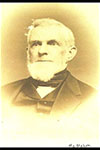
Elza A. McMahon
1852-1855
The first Circuit Court Judge was Elza A. McMahon who served from 1852 through 1855. Prior to the formation of the 10th Judicial Circuit, McMahon had served as a Prosecuting Attorney and Judge of the Allen Circuit Court. He lived in Fort Wayne, having arrived from Ohio in about 1845. He was about 42 years of age when he became a Judge and was unmarried. He was regarded as a fair lawyer, high minded, and pleasant as a Judge. Although delicate in health, and occasionally melancholy, he was at times witty and fond of humor. In 1855 after leaving the bench, he traveled to Rochester, Minnesota. Rochester was a new community at that time. McMahon served as Prosecuting Attorney and President of the local bar association. It was reported that he became a mental wreck and traveled, along with a few others, to Leon County, Florida in 1876, where he became an acting District Judge. He died in Tallahassee, Florida on September 26, 1879.
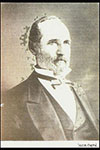
James L. Worden
1855-1858
James L. Worden served as Circuit Court Judge from 1855 through 1858. He had been a Prosecuting Attorney. He was born in 1819 in Massachusetts and was one of the early residents of Noble County. It is reported that from the time he first pitched his tent here, his course had been steadily upward. He served three years as Prosecutor and was appointed Judge. In January 1858, he resigned and ultimately became a Judge on the Indiana Supreme Court. He later served as Mayor in Fort Wayne and again sat on the Supreme Court. It is written that his decisions were quoted “ wherever the principles of the common law prevailed.” He was described as “quiet and unassuming in his manners, calm, and deliberate in his judgment, and was generally correct in his conclusions.”
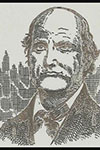
Rueben J. Dawson
1858
Rueben J. Dawson was appointed by the Governor in January 1858. He was born in 1811 and had moved from Fort Wayne to DeKalb County, where he platted the Town of Spencerville and surveyed much of Noble and LaGrange Counties. He served in both branches of the legislature prior to being appointed Judge of the Circuit Court. During his term, Noble County suffered from many horse thieves and counterfeiters. Dawson couldn’t be intimidated. He held court in Albion soon after the Regulators had hanged Gregory McDougall. Regulators planned to challenge the court’s authority, but Dawson proved equal to the emergency. Described as “faithful, conscientious, energetic, pure, impartial and efficient,” Dawson resigned for health reasons and died in 1859.

Edward R. Wilson
1858-1864
Edward R. Wilson served from 1858 through 1864. He was a young man at the time of his election, residing in Bluffton. He was described as impulsive and quick to form his conclusions, yet his decisions generally stood the test in the Supreme Court, the best evidence that he was correct. He was a popular officer, and yet from his peculiar temperament, was liable to make warm friends or bitter enemies He had served as Prosecutor and when elected Judge at the age of 32 enjoyed the distinction of being the youngest judge in the state, presiding over the largest judicial circuit therein. He was later elected to a term as State Senator and died in Bluffton in 1879.
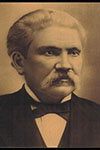
Robert R. Lowery
1864-1867
Robert R. Lowery served from 1864 through 1867. He was born in Ireland and resided in Fort Wayne after beginning his practice of law at Goshen. He was recognized as one of the best attorneys in the state and later became a Judge of the Allen Superior Court in 1879. Lowery was the first president of the Indiana Bar Association. He served two terms in Congress beginning in 1882. Lowery “gives the question of the day that calm, judicial examination which only a trained intellect can bestow.” Noble County was removed from his judicial district in 1867.
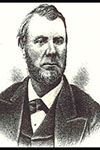
Hiram S. Tousley
1867-1872 & 1876-1882
Hiram S. Tousley has the distinction of serving twice as our Circuit Court Judge. His initial term was from 1867 through 1872 and later from 1876 to 1882 when the judicial circuits were reorganized. Tousley was born in New York in 1821, later became a resident of Albion, and was probably as well known as any one living in Albion. He attended I.U. and had been identified with the interest of our county. He served as Clerk prior to his appointment in 1867. He had a “remarkable, retentive memory and as a scholar of history has few equals.” He became paralyzed in 1880 and served until 1882.

James I. Best
1872-1876
James I. Best of DeKalb County served from 1872 through 1876. He “discharged the duties of the position in a manner at once credible to himself and acceptable to his people.” His business interest, however, required his attention at home and he resigned from the office. He was later employed by the Lake Shore and Michigan Southern Railroad Company as attorney, formed the DeKalb Bank, and owned a flour mill in Waterloo. From 1881 through 1885 he was appointed as one of the commissioners to assist the judges of the Indiana Supreme Court. He moved to Minneapolis, Minnesota and practiced law with his son until his death in 1919.
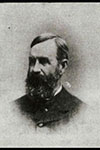
Joseph A. Woodhull
1876
Joseph A. Woodhull served in part during part of the year 1876, until the district was reformed and Hiram S. Tousley again became Judge. Born in 1828 in New York, he moved to Michigan and attended Michigan Central College at Spring Arbor. He began reading medicine in Fremont but soon changed to law. Woodhull served as a Legislator in 1861, prior to his judicial appointment in 1876. Woodhull died in 1912.

Robert W. McBride
1882-1888
Robert W. McBride served from 1882 to 1888. Prior to that, McBride had the distinction as serving as a personal bodyguard to President Abraham Lincoln. McBride is mentioned twice in Carl Sandburg’s biography of Abraham Lincoln and he wrote a book, published in 1911. In 1866 McBride returned to Waterloo and began studying law. After serving as our Circuit Court Judge, he moved to Elkhart and practiced there for a short period of time before becoming a Justice on the Indiana Supreme Court. He passed away in Indianapolis in 1926 at the age of 84. He is pictured both in his Civil War uniform and as a Supreme Court Justice
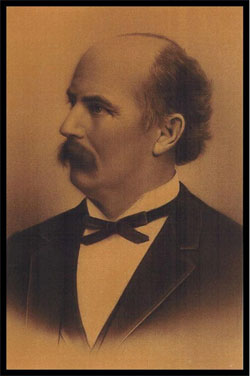
Stephen A. Powers
1888-1889
Stephen A. Powers served as Circuit Judge from 1888 through 1889. His family migrated from New York to Steuben County. Born in 1851, Powers was a scholar and his obituary noted that during his term as judge, he “tried and disposed of many of the most noted and important cases ever tried in this court.” When he retired from office, he took with him the “respect, confidence and esteem of all that knew him, and universal commendation for his honesty, fairness, and conscientious regard for the right.” He served as a state senator and when he died in 1913, it was said that “this world has been made better by and through Stephen A. Powers and his having lived in it.”
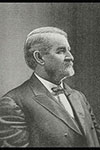
Joseph W. Adair
1889-1908
Joseph W. Adair served from 1889 through 1908. While he was born in Noble County in 1843, his father was born in Ireland and came to America in early childhood. Judge Adair attended Wabash College and studied law, resulting in his admission to the Whitley County Bar in 1869. It was reported that there was seldom a case of any import in which he did not appear either for the plaintiff or defense. He appeared for a defendant, Dr. Gotwald of Springfield, Ohio, charged with preaching and teaching doctrines contrary to the accepted creed of his church, facing a charge of heresy. He served one year as superintendent of the Whitley County Schools, was Mayor of Columbia City, and was described as an “able, brilliant, and honest lawyer.” Judge Adair served as the first circuit court judge in the current Noble County Courthouse.
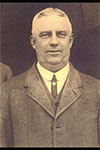
Luke H. Wrigley
1908-1920
Luke H. Wrigley was born in Richmond, Indiana, in 1856. He studied law in Richmond and was admitted to the Wayne County Bar in 1879. He was located in Albion in 1881 and served as Judge from 1908 to 1920. Judge Wrigley was well respected and exhibited a keen sense of humor from the bench. He was a moving force behind establishing a Carnegie Library in Albion. Wrigley died in Albion in 1946.

Arthur F. Biggs
1920-1931
Arthur F. Biggs served from 1920 to 1931. Born in Kosciusko County in 1866, he was the son of Kosciusko Circuit Court Judge Hiram Biggs in Warsaw who served there from 1896 to 1904. Arthur Biggs attended Michigan University. Prior to his election, he practiced law with his father in Warsaw. He moved to Ligonier and became the attorney for Straus Bros. until elected judge. He loved baseball, and served during Prohibition, facing many moonshine cases. Stories reflect that he had a sympathetic heart for the down and out. Judge Biggs died in 1931, while serving his second term.
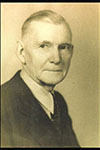
George L. Foote
1931-1932
George L. Foote was appointed in 1931 to fill the last 16 months of the unexpired term of Judge Biggs. Born in 1867, Foote had practiced in Albion and served as County Clerk. Prior to that, he was a Captain in 1916 in the Mexican Border War and also served in World War I. After filling out the judicial term, he returned to practice in Albion until his death in 1945.
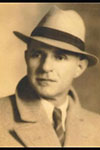
Rob R. McNagny
1932-1938
Rob R. McNagny, son of a Congressman, served as the last joint circuit court judge from 1932 to 1938. Born in Columbia City in 1884 he attended Wabash College and graduated from the Chicago Art Institute. He joined his father’s law firm, yet remained an accomplished artist and author. A dashing and beloved figure, McNagny died in 1974.
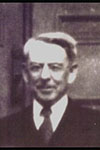
Fred L. Bodenhafer
1939-1950
In 1939 Noble County became its own judicial circuit. Fred L. Bodenhafer was elected Judge and served until 1950. Born in 1876, Bodenhafer lived in Kendallville and was up in years when elected. He was known to be short-tempered and pointed, but a keen legal scholar. He had little use for attorneys he regarded as less intelligent than he. Bodenhafer had served in the General Assembly in 1905. He died in 1952.

Kenneth A. King
1950-1962
Kenneth A. King was elected in 1950 and served until 1962. Born in Somerset, Indiana in 1912, he attended IU Undergraduate and Law School. He moved to the Rome City area prior to becoming a judge. King often bragged he had knocked on every door in the county and won election easily. He presided over the highly public trial involving the embezzlement of funds from the Noble County Credit Union the formation of the current public school districts and the appointment of school board members. The school consolidation issue was very emotional and divisive and Judge King believed this issue caused him to lose his bid for re-election.
Judge King died on February 17, 2016, at the age of 103 and is buried at Mississinewa Memorial Cemetery in Wabash.
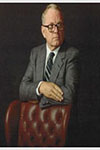
John C. Hagen
1963-1974
John C. Hagen served from 1963 through 1974. Born in Morocco, Indiana in 1919, John attended Indiana University and was a lifelong fan of their football and basketball teams. John also coached American Legion baseball. Judge Hagen always believed that there was good in everyone and he attempted to bring out that good, if possible. He had a keen sense of humor and was universally liked and respected. Hagen later practiced in Syracuse until his death in 1995. It was written that all will miss “his sunny smile, infectious wit, kind heart and good works.”
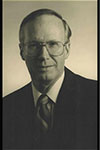
Robert C. Probst
1975-1998
Robert C. Probst has the distinction of serving the longest time on the bench, from 1975 through 1998. He graduated from Valpo Law School and practiced with his father. During his tenure the courtroom was reversed from the south side to the north side, two Superior Courts were added and the caseload grew. Judge Probst became one of the most beloved and respected judges in the state, having a reputation of honesty and fairness. Adjoining counties often venued cases to Judge Probst. His strong faith and devotion to his family gained him great respect in the community. Born in Kendallville, Indiana in 1934, he survives today.

G. David Laur
1999-Present
G. David Laur assumed the bench in 1999, having served as Noble County Prosecutor from 1975 to 1998. He is the longest-serving elected official in Noble County history. Born in 1947 in Hudson, Michigan, he graduated from high school in Holgate, Ohio in 1965, attended undergraduate and law school at The Ohio State University and passed the Indiana Bar in 1972.
While Prosecutor, he obtained a death sentence verdict for the murderer of Avilla Town Marshall William Miner in 1983. Laur was also instrumental in obtaining convictions for child neglect against Faith Assembly members whose children died when members failed to seek medical attention.
In 2002, Judge Laur spearheaded the renovation of the Circuit Courtroom and assembled the photos and biographies of the former judges. He created the Noble County Courts Webpage, with links. In 2013, Judge Laur headed the formation of the Community Corrections program, used to monitor and rehabilitate low risk offenders.
Note: Prior to the creation of judicial circuits, there were judges appointed by the Governors of Indiana.
| President Judges | |
|---|---|
| Gustavus A. Everts | 1836 |
| Samuel C. Sample | 1836 |
| Charles W. Ewing | 1836-1839 |
| Dudley H. Chase | 1839 |
| John W. Wright | 1839-1841 |
| James E. Borden | 1841-1852 |
| Associate Judges | |
| Elisha Blackman | 1836-1843 |
| James Latta | 1836-1843 |
| Jacob Stage | 1843-1850 |
| Thomas H. Wilson | 1841-1848 |
| Edwin Randall | 1843-1850 |
| David S. Simons | 1850-1857 |
| Probate Judges | |
| Horatio M. Slack | 1844 |
| Henry R. Burnam | 1845-1849 |
| Harrison Wood | 1849-1852 |
| Common Pleas Judges | |
| Stephen Wildman | 1852-1856 |
| James C. Bodley | 1856-1859 |
| Sanford J. Stoughton | 1859-1860 |
| William M. Clapp | 1860-1873 |
Noble County
Helpful Links
Contact Us
109 N York St
Albion, IN 46701
Office Hours: 8:00 am - 4:00 pm Monday-Friday
